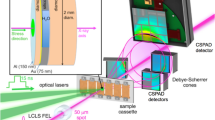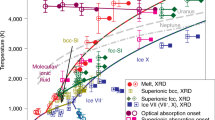Abstract
Gas hydrates are ice-like solids, in which guest molecules or atoms are trapped inside cages formed within a crystalline host framework (clathrate) of hydrogen-bonded water molecules1. They are naturally present in large quantities on the deep ocean floor and as permafrost, can form in and block gas pipelines, and are thought to occur widely on Earth and beyond. A natural point of reference for this large and ubiquitous family of inclusion compounds is the empty hydrate lattice1,2,3,4,5,6, which is usually regarded as experimentally inaccessible because the guest species stabilize the host framework. However, it has been suggested that sufficiently small guests may be removed to leave behind metastable empty clathrates7,8, and guest-free Si- and Ge-clathrates have indeed been obtained9,10. Here we show that this strategy can also be applied to water-based clathrates: five days of continuous vacuum pumping on small particles of neon hydrate (of structure sII) removes all guests, allowing us to determine the crystal structure, thermal expansivity and limit of metastability of the empty hydrate. It is the seventeenth experimentally established crystalline ice phase11, ice XVI according to the current ice nomenclature, has a density of 0.81 grams per cubic centimetre (making it the least dense of all known crystalline water phases) and is expected7,12 to be the stable low-temperature phase of water at negative pressures (that is, under tension). We find that the empty hydrate structure exhibits negative thermal expansion below about 55 kelvin, and that it is mechanically more stable and has at low temperatures larger lattice constants than the filled hydrate. These observations attest to the importance of kinetic effects and host–guest interactions in clathrate hydrates, with further characterization of the empty hydrate expected to improve our understanding of the structure, properties and behaviour of these unique materials.
This is a preview of subscription content, access via your institution
Access options
Subscribe to this journal
Receive 51 print issues and online access
$199.00 per year
only $3.90 per issue
Buy this article
- Purchase on Springer Link
- Instant access to full article PDF
Prices may be subject to local taxes which are calculated during checkout


Similar content being viewed by others
References
Sloan, E. D. & Koh, C. A. Clathrate Hydrates of Natural Gases 3rd edn (CRC Press, Taylor & Francis Group, 2008)
van der Waals, J. H. & Platteeuw, J. C. Clathrate solutions. Adv. Chem. Phys. 2, 1–57 (1959)
Ballard, A. L. & Sloan, E. D. The next generation of hydrate prediction I. Hydrate standard states and incorporation of spectroscopy. Fluid Phase Equilib. 194–197, 371–383 (2002)
Belosludov, V. R. et al. Thermal expansion and lattice distortion of clathrate hydrates of cubic structures I and II. J. Supramol. Chem. 2, 453–458 (2002)
Koyama, Y., Tanaka, H. & Koga, K. On the thermodynamic stability and structural transition of clathrate hydrates. J. Chem. Phys. 122, 074503 (2005)
Matsumoto, M. & Tanaka, H. On the structure selectivity of clathrate hydrates. J. Phys. Chem. B 115, 8257–8265 (2011)
Jacobson, L. C., Hujo, W. & Molinero, V. Thermodynamic stability and growth of guest-free clathrate hydrates: a low-density crystal phase of water. J. Phys. Chem. B 113, 10298–10307 (2009)
Wooldridge, P. J., Richardson, H. H. & Devlin, J. P. Mobile Bjerrum defects — A criterion for ice-like crystal-growth. J. Chem. Phys. 87, 4126–4131 (1987)
Guloy, A. M. et al. A guest-free germanium clathrate. Nature 443, 320–323 (2006)
Gryko, J. et al. Low-density framework form of crystalline silicon with a wide optical band gap. Phys. Rev. B 62, R7707–R7710 (2000)
Bartels-Rausch, T. et al. Ice structures, patterns, and processes: a view across the icefields. Rev. Mod. Phys. 84, 885–944 (2012)
Conde, M. M., Vega, C., Tribello, G. A. & Slater, B. The phase diagram of water at negative pressures: Virtual ices. J. Chem. Phys. 131, 034510 (2009)
Gies, H., Liebau, F. & Gerke, H. “Dodecasile” - eine neue Reihe polytyper Einschlußverbindungen von SiO2 . Angew. Chem. 94, 214–215 (1982)
Falenty, A., Salamatin, A. N. & Kuhs, W. F. Kinetics of CO2-hydrate formation from ice powders: data summary and modeling extended to low temperatures. J. Phys. Chem. C 117, 8443–8457 (2013)
Alavi, S. & Ripmeester, J. A. Hydrogen-gas migration through clathrate hydrate cages. Angew. Chem. Int. Edn 46, 6102–6105 (2007)
Senadheera, L. & Conradi, M. S. Rotation and diffusion of H2 in hydrogen – Ice clathrate by 1H NMR. J. Phys. Chem. B 111, 12097–12102 (2007)
Dyadin, Y. A. et al. Clathrate formation in water-noble gas (hydrogen) systems at high pressures. J. Struct. Chem. 40, 790–795 (1999)
Mao, W. L. et al. Hydrogen clusters in clathrate hydrate. Science 297, 2247–2249 (2002)
Evans, J. S. O. Negative thermal expansion materials. J. Chem. Soc. Dalton Trans. 3317–3326 (1999)
Tang, X. L. et al. Thermal properties of Si-136: Theoretical and experimental study of the type-II clathrate polymorph of Si. Phys. Rev. B 74, 014109 (2006)
Röttger, K., Endriss, A., Ihringer, J., Doyle, S. & Kuhs, W. F. Lattice constants and thermal expansion of H2O and D2O ice Ih between 10 and 265 K. Acta Crystallogr. B 50, 644–648 (1994); Addendum. Acta Crystallogr. B 68, 91 (2012)
Tanaka, H. Thermodynamic stability and negative thermal expansion of hexagonal and cubic ices. J. Chem. Phys. 108, 4887–4893 (1998)
Pamuk, B. et al. Anomalous nuclear quantum effects in ice. Phys. Rev. Lett. 108, 193003 (2012)
Lobban, C., Finney, J. L. & Kuhs, W. F. The structure of a new phase of ice. Nature 391, 268–270 (1998)
Kuhs, W. F., Sippel, C., Falenty, A. & Hansen, T. C. Extent and relevance of stacking disorder in “ice Ic”. Proc. Natl Acad. Sci. USA 109, 21259–21264 (2012)
Rodger, P. M. Lattice relaxation in type I gas hydrates. AIChE J. 37, 1511–1516 (1991)
Kuo, J. L., Klein, M. L. & Kuhs, W. F. The effect of proton disorder on the structure of ice-Ih: A theoretical study. J. Chem. Phys. 123, 134505 (2005)
Kumar, P. & Sathyamurthy, N. Theoretical studies of host-guest interaction in gas hydrates. J. Phys. Chem. A 115, 14276–14281 (2011)
Anderson, B. J., Bazant, M. Z., Tester, J. W. & Trout, B. L. Application of the cell potential method to predict phase equilibria of multicomponent gas hydrate systems. J. Phys. Chem. B 109, 8153–8163 (2005)
Weaire, D. & Phelan, R. A counterexample to Kelvin conjecture on minimal-surfaces. Phil. Mag. Lett. 69, 107–110 (1994)
Hansen, T. C., Henry, P. F., Fischer, H. E., Torregrossa, J. & Convert, P. The D20 instrument at the ILL: a versatile high-intensity two-axis neutron diffractometer. Meas. Sci. Technol. 19, 034001 http://dx.doi.org/10.1088/0957-0233/19/3/034001 (2008)
Rodríguez-Carvajal, J. Recent advances in magnetic-structure determination by neutron powder diffraction. Physica B 192, 55–69 (1993)
Kuhs, W. F. Generalized atomic displacements in crystallographic structure-analysis. Acta Crystallogr. A 48, 80–98 (1992)
James, F. Monte-Carlo theory and practice. Rep. Prog. Phys. 43, 1145–1189 (1980)
Peters, B., Zimmermann, N. E. R., Beckham, G. T., Tester, J. W. & Trout, B. L. Path sampling calculation of methane diffusivity in natural gas hydrates from a water-vacancy assisted mechanism. J. Am. Chem. Soc. 130, 17342–17350 (2008)
Buch, V. et al. Clathrate hydrates with hydrogen-bonding guests. Phys. Chem. Chem. Phys. 11, 10245–10265 (2009)
Demurov, A., Radhakrishnan, R. & Trout, B. L. Computations of diffusivities in ice and CO2 clathrate hydrates via molecular dynamics and Monte Carlo simulations. J. Chem. Phys. 116, 702–709 (2002)
Acknowledgements
We thank the Bundesministeriums für Bildung und Forschung (BMBF) for financial support in the context of the first and second phase of the German SUGAR (SUbmarine Gashydrat-Lagerstätten: Erkundung, Abbau und TRansport) project. We thank the Institut Laue-Langevin (ILL) for beam time and support. We are also grateful for the assistance of H. Bartels (Göttingen), U. Kahmann (Göttingen) and A. Daramsy (ILL), as well as for discussions with P. Lafond (Göttingen).
Author information
Authors and Affiliations
Contributions
W.F.K. and A.F. designed the study and prepared the Ne-hydrate samples; A.F., T.C.H. and W.F.K. performed the leaching and diffraction experiments; T.C.H. and W.F.K. analysed the data; and W.F.K. wrote the paper with contributions from A.F. and T.C.H.
Corresponding author
Ethics declarations
Competing interests
The authors declare no competing financial interests.
Extended data figures and tables
Extended Data Figure 1 Cage filling as a function of time for different temperatures.
A shrinking core model of the Ne leaching process fits values from sequential Rietveld refinement. Filled data points (and solid line for the fits) present the data for small cages (Ne1); open data points (and dashed lines) show data for the large cages (Ne2). Red circles and lines represent 110 K, orange squares and lines 120 K, green triangles and lines 130 K, light blue triangles and lines 135 K, dark blue flat rhombi and lines 140 K, magenta upright rhombi and lines 145 K.
Extended Data Figure 2 Diffraction patterns of Ne-filled and empty hydrate.
a, b, Rietveld fit (obtained using FullProf software32) to diffraction pattern of empty sII D2O hydrate (a) and Ne D2O hydrate (b) taken at 5 K (λ ≈ 1.1226 Å) on D20, ILL/Grenoble. The observed intensity is represented by open black circles, the calculated intensity as a blue line, the difference of both by a green line, grey shading marks the angular regions excluded in the refinement, red lines mark the positions of Bragg peaks of the hydrate, violet lines those of the aluminium sample can and orange lines those of ice Ic.
Supplementary information
Supplementary Data
This zipped file contains 2 crystallographic information files. (ZIP 13 kb)
PowerPoint slides
Source data
Rights and permissions
About this article
Cite this article
Falenty, A., Hansen, T. & Kuhs, W. Formation and properties of ice XVI obtained by emptying a type sII clathrate hydrate. Nature 516, 231–233 (2014). https://doi.org/10.1038/nature14014
Received:
Accepted:
Published:
Issue Date:
DOI: https://doi.org/10.1038/nature14014
This article is cited by
-
Hydrogen over helium: A philosophical position
Foundations of Chemistry (2024)
-
Atomistic-geometric simulations to investigate the mechanical stability of monocrystalline sI methane hydrates under pressure
Scientific Reports (2023)
-
Neon encapsulation by a hydroquinone organic crystalline clathrate under ambient conditions
Communications Materials (2023)
-
Molecular Dynamic Simulations of Clathrate Hydrate Structures I: Lattice Constant and Thermal Expansion
Journal of Low Temperature Physics (2022)
-
The everlasting hunt for new ice phases
Nature Communications (2021)
Comments
By submitting a comment you agree to abide by our Terms and Community Guidelines. If you find something abusive or that does not comply with our terms or guidelines please flag it as inappropriate.



